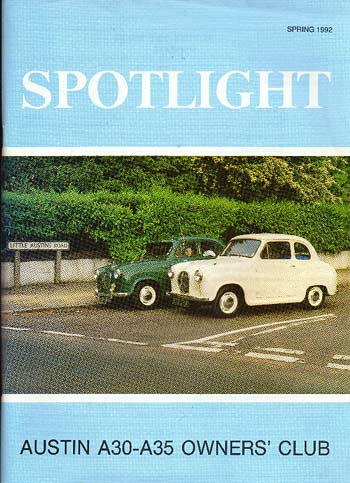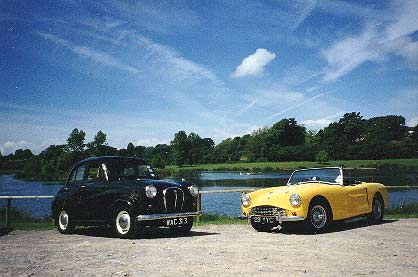| Turner Sports Cars | Articles |
| Turner Sports Cars | Articles |

| As you may know back in the 50's there were many small sports car firms who utilised technical components from popular cars as the basis for theirs. Such firm included Gilburn, Fairthorpe and Peerless as well as many now famous firms such as Lotus, TVR and Marcos. One such firm was Jack Turner's and it is safe to say that his was the first to see the A30 in the sports car light after longbridge had decided not to go ahead with the 7hp sports A30. Of course, as you would expect, Barney Sharratt covers Turners in his very thorough book, "Post War Baby Austins" from which the next paragraphs are taken; (with his kind permission) |
| Austin may not have wished to dabble in fibreglass bodies, but the possibility of A30 mechanical parts mated with a lightweight frame and plastic body caught the imagination of Jack Turner. In the early 1950's, he had produced several cars that utilised a variety of mechanical parts, but by 1955, he had settled on his new recipe. The main frame was to consist of two 3 in dia. longitudinal members,to which were added cross tubes and out riggers. The chassis proper terminated ahead of the rear axle, reminiscent of a similar arrangement of the pre-war Austin 7. In this case though, the A30 axle was located by trailing arms and a Panhard rod, and it employed either torsion-bar or coil spring suspension. The telescopic rear dampers were supported on out riggers. The front suspension was standard A30, except that lighter springs were fitted to match the car's very low kerb weight of about 11cwt. Jack Turner was a racing driver and enthusiast whose cars were always built with the possibility of competition in mind, so the rack and pinnion steering of the Minor was preferred to the A30's set-up. Twin SU's were added to a virtually standard A30 engine and gearbox, but 15in wheels raised the gear ratios considerably.
In Jack Turner's own words, "The fibreglass moulding for the body was made in one piece, the only separate pieces being the bonnet, boot lid and doors. The main shell was bolted to the steel inner structure through suitable steel reinforcements bonded to the inside of the moulding. I had a number of meetings with George Harriman at Longbridge with the aim of either a joint operation or, failing that, a direct supply of components at a manufacturer's price. This was not to be, and it was very annoying to find that three years later after, he made a deal with Healey to produce the Sprite, which was a replica in many respects. We were forced to obtain our supplies through Austin dealers, and this increased the price considerably". You could buy a Turner A30 or 803 as it was known, either fully assembled at £525 plus £264 purchase tax (a total of £789), or you could purchase it as a kit of parts, in which case it was exempt from tax. The car had a claimed top speed of about 80 mph in standard form, and at cruising speeds it could return 40-50 mpg. The 803 had a fairly short production run, because with the arrival of the A35, Turner took advantage of the new engine, gearbox and 4.55:1 rear axle ratio. From 1956-59, the car became the Turner 950. About 270 of these 803 and 950 cars were built before the Mk 1 Sports was introduced. This would do 0-60 in 12 seconds and carry on to reach some 95 mph. It had a completely new fibreglass body, but was only in production for one season. As well as the 948 cc version, which used BMC components, the car was offered with a Coventry Climax Engine. The Turner had always been competitive, but by now, it was becoming quite a potent machine. An Alexander version of the Mk1 had the 948 cc engine with 9.4:1 compression ratio and cross flow alloy head. From 1962 onwards, the BMC engine was only offered as an option to Ford units. By offering the mechanical parts of the A30 and A35 in a cleverly designed, lightweight package, Jack Turner had brought very pleasurable motoring and, in many cases, much fun and success on the race track to quite a few enthusiasts who could not have afforded it otherwise. Turner 950's came 1st and 2nd in the Autosport Championship of 1958, and a flip through the motor racing press of 1955-65 leaves one in no doubt that the Turner was a very competitive car. Unfortunately, without the co-operation of Longbridge, it was impossible to appeal to a mass market. The A30 (and later 950) were definately cars for the enthusiast. My first encounter with a Turner, or rather one's owner was back in 1984 whilst rubbing down my first car for a "cheap and cheerful" paint job, Terry came up and introduced himself and offered to help with any parts I may need as his yellow sports car was based on one. At that time I had no idea what his car was but I was very used to seeing him in it as our garages are only a few hundred yards apart on the same road. Since then we have remained good friends, and along with this son, keen classic car followers. As time went on he told me more about Turner's and the very close relationship they have to our Austins. Terry's now runs on a 1098 cc engine and gearbox as when he got the car the original engine was needing a rebuild. Unfortunately he threw away the old engine which he later discovered to be fully race prepared! As well as the engine and box the Turner also uses the A35 axle with trailing arms and panhard rod, the front suspension, and other more visible items such as a front bumper, re-circulatory type heater, gear lever gaitor and lights. So what you basically have in the Turner is an A35 albeit in a much lighter and sportier body with a much greater performance. Originally the Mk1 was fitted with twin 1 ¼" SU's but for practical reasons, Terry has gone over to a single 1½" SU. The car, a 1960 specimen, was bought for just £50 back in 1975 and then took some 7 years to restore. This was done in true home style and I remember seeing the body off and the rolling chassis standing in the driveway. Terry still adds to it all the time although there isn't much left to do as it is probably the best example of the Marque still remaining in this country. It is also now quite used to exposure, it was featured in an article for Classic and Sports Car back in 1984 and more recently it was used in a pop video, to be shown over the summer on Pebble Mill, and the Val Doonigan Show, so keep your eyes peeled. After the Classic and Sports Car article the original owner of the car contacted Terry and shed a lot of light on the car's racing history as well as providing copies of the original bill of sale and hand book. Apparently the car was destined for export having both the A35 handbrake lever and the Turner exhaust mounted on the nearside as opposed to offside. The car was used for sprints and hill climbs when it was new and in 1961 held the Best in Class title for the Weston Speed Trials. He also turned up some interesting film of the car on holiday in Le Mans when it actually went round the track. Praise for the handling was noted in the C.A.S.C. article when the author, Mike Walsh commented "Driving the Turner is reminiscent of guiding a powerful motorcycle through fast bends. The handling is simply superb once you've attuned to its precise characteristics, and the equal weight distribution at front and rear prove the invaluable race experience of Jack Turner". The photographs were taken last year at a local lake with my 1957 1275 cc powered A35. Although my car now has a bigger engine than the Turner I know there is not way I could ever keep up with it and wouldn't even attempt to. It is nice to know that our cars were the inspiration behind such a sleek and fast sports car. Unfortunately there were only 100 Mk1 Turner's built so to see one these days is a rare sight indeed. There is a Turner Club and at a recent rally Terry was fortunate enough to meet Jack Turner and have his photo taken with the car. |
| I'd like to thank Terry Filby for his help in writing this article, and Barney Sharratt for allowing me to reproduce from his book.
Paul Lewis Nailsea, Bristol |
 |